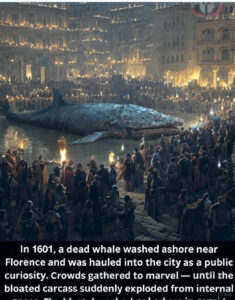The Renaissance loved wonders — exotic animals, oddities, and “marvels of nature.” But one marvel turned into a nightmare.

In 1601, a massive whale washed up along the Tuscan coast. The creature was dragged to Florence, where curious citizens flocked to see this giant of the seas. For days, the whale lay on display, a symbol of nature’s power and mystery.
But as it rotted in the sun, something sinister brewed inside. Gases from decomposition built pressure within the carcass until, suddenly, the whale exploded with a thunderous blast. The eruption sprayed putrid flesh and entrails across the crowd, coating streets and buildings in foul remains. Chroniclers claimed the stench was so unbearable that it lingered for weeks, forcing people to flee the area.
What began as civic pride in showing off a natural wonder ended as horror and disgust. Renaissance Florence, a city famed for its art and refinement, found itself covered in rotting whale guts.
The Exploding Whale of 1601 is a grim reminder: when humans turn nature into spectacle, sometimes nature has the last word.
Leave a Reply